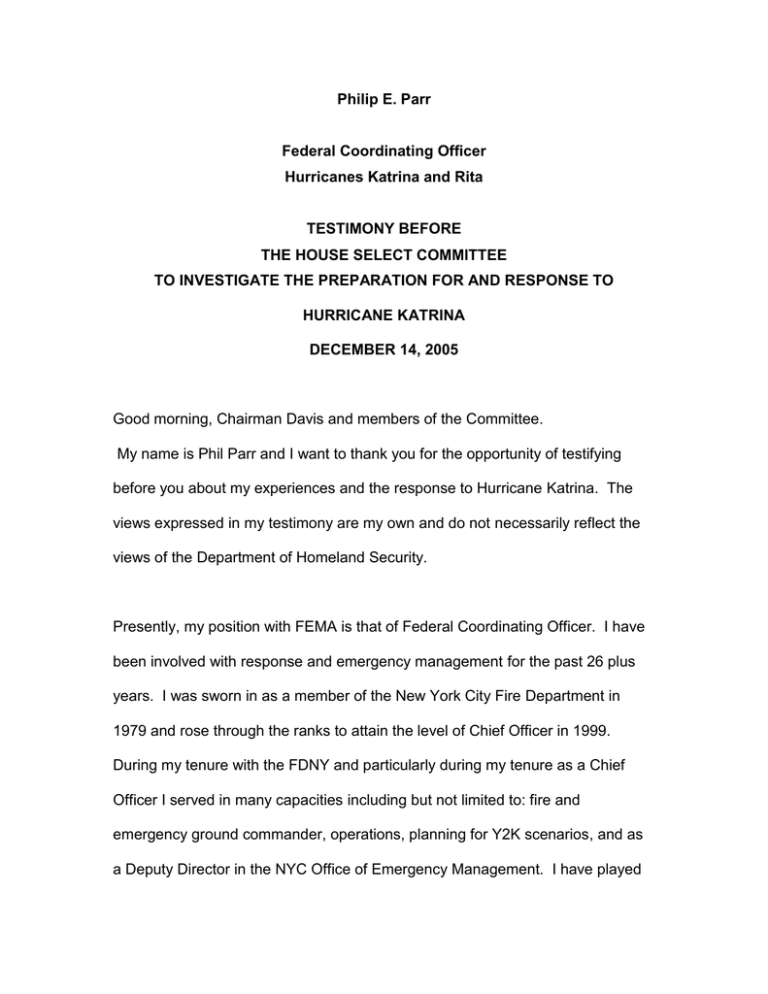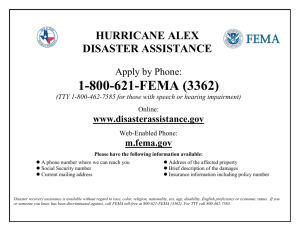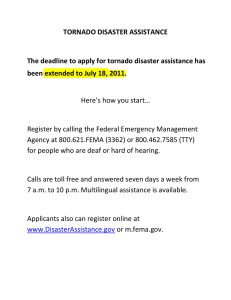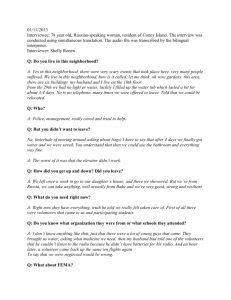Philip E. Parr Federal Coordinating Officer Hurricanes Katrina and Rita
advertisement

Philip E. Parr Federal Coordinating Officer Hurricanes Katrina and Rita TESTIMONY BEFORE THE HOUSE SELECT COMMITTEE TO INVESTIGATE THE PREPARATION FOR AND RESPONSE TO HURRICANE KATRINA DECEMBER 14, 2005 Good morning, Chairman Davis and members of the Committee. My name is Phil Parr and I want to thank you for the opportunity of testifying before you about my experiences and the response to Hurricane Katrina. The views expressed in my testimony are my own and do not necessarily reflect the views of the Department of Homeland Security. Presently, my position with FEMA is that of Federal Coordinating Officer. I have been involved with response and emergency management for the past 26 plus years. I was sworn in as a member of the New York City Fire Department in 1979 and rose through the ranks to attain the level of Chief Officer in 1999. During my tenure with the FDNY and particularly during my tenure as a Chief Officer I served in many capacities including but not limited to: fire and emergency ground commander, operations, planning for Y2K scenarios, and as a Deputy Director in the NYC Office of Emergency Management. I have played an active role in countless disasters and crisis situations, to include the 9/11 attack at the WTC where I was on scene prior to the towers collapse. Since January 2004, I have been a member of the Federal Coordinating Officer (FCO) program assigned to FEMA Region 1, New England. In this role I have served in various capacities including FCO for three Presidentially declared disasters. Before I continue with my testimony I think it important to mention that I’ve always taken great pride in my years of service as a member of the NYC Fire Department. I could not imagine serving in any other position in which I would serve with the same feeling and pride. However, during my tenure with FEMA, the dedication to service as displayed by its members and their care for disaster victims has allowed me to serve with the same pride and satisfaction that I experienced in my previous 25 years of public service. So it is with that passion that I speak before this committee and I thank you again for the opportunity to do so. On Saturday August 27th I was informed that I would be the Emergency Response Team Advance Element team leader for the State of Texas. My team was composed of personnel from FEMA, Region 1 (New England), and we were instructed to rendezvous in the Region 6, Regional Response Coordination Center in Denton, TX. Sunday August 28th. Soon it became clear that Texas was not in the path of Hurricane Katrina and that members of my team and I would be assigned as the lead element in New Orleans, La. I flew into Louisiana, immediately following the hurricane passing Monday 29th of August with a contingent of my team, and Tuesday morning on the 30th we helicoptered into the Superdome. Our mission was three fold: (1) form a unified command with the State (as represented by the Louisiana National Guard), and the City of New Orleans; (2) maintain visibility of commodities ordered; and (3) build out a base from which FEMA teams could be formed to locate and assist in the hardest hit Parishes. To accomplish these goals we were to meet a Mobile Emergency Operations and Communications Vehicle and use that as a base of operations and communication. Due to extensive flooding in the City our communications vehicle was unable to enter the Dome and this severely hampered our operations. Despite this, and while working under the most difficult of circumstances, we were able to assist the National Guard in maintaining a supply of food and water to Superdome evacuees, all were fed and provided water, and even with limited communications, facilitate the arrival of what was to become over the next four days, a thousand bus convoy to evacuate the City of New Orleans to start the day after our arrival. The FEMA Disaster Medical Assistance Teams treated hundreds, and identified seriously injured and special needs patients who were evacuated via air and ground assets throughout the operation. In addition, several meetings were held with the Mayor and his staff, ranking National Guard Officers on scene, and other Federal Officials to include DOD and the USCG, this facilitated the initiation of a unified command structure. Due to the enormity of the event, not all of our initial goals were met, and a delay ensued in placing teams into other hard hit parishes, which I believe took place that Friday/Saturday. I have been asked whether FEMA was overwhelmed and could our response be considered slow. To consider the latter first, I must say in my opinion No. FEMA teams (response, management, medical, and Urban Search and Rescue) were in position in four States pre-land fall. Commodities were staged close to the impacted areas and in some cases the hand-off to the State had already taken place. In addition and as previously mentioned, FEMA mission assigned Emergency Support Function (ESF) 1, the Department of Transportation, and they verified that by 3 September 990 busses were in service performing evacuations and it is estimated that 66,825 persons were transported by that date. The number of buses grew to over 1100 in the next two days. Also, we pushed our logistics capabilities and in the first 6 days after Katrina’s landfall, FEMA sent more trucks of supplies for Katrina victims than were delivered in Florida the entire 7 weeks of the response to the four hurricanes last year. Were we overwhelmed? The simple answer is, Yes. But what needs to be understood is that at any disaster the initial response always feels overwhelmed. I must draw on my experience as a local responder to give you an example on a small scale of what I mean, and then a larger one. The police officer who pulls up to a two car accident with severe injuries while he operates alone waiting for help is overwhelmed. The fire officer who pulls up to a burning structure with people trapped inside is overwhelmed. But the true professional while responding and operating knows that he is constantly sizing up the situation, gaining intelligence, shifting strategies, modifying plans, and calling for assistance where needed to meet unfulfilled needs whether expected or unexpected. I would like to refer back to the disaster of 9/11 and its effect on the emergency personnel operating at the WTC. First, it must be remembered that within the 369 square miles of NYC are the resources of a State with a strong central government. There are over 35,000 NYC police officers, about 13,000 firefighters and emergency medical personal, and these numbers only begin to enumerate the assets available to the City. No other city in the country can begin to come close to the responders contained within the City of New York. The response to the attacks on the towers was immediate; the enormity of the task at hand was overwhelming. Then with the collapse of the towers it was chaos. Emergency services within NYC regrouped almost immediately and restarted operations, but a full coordinated plan took days. The WTC complex was thirteen acres. The landfall of Hurricane Katrina affected four States and covered an area of some 90,000 square miles, an area the size of Great Britain and it affected millions of persons. Effectively Louisiana was hit by two disasters, first a devastating hurricane along with its associated blast damage, and second a catastrophic flooding event caused by levee failures. Hurricane Katrina was the most devastating disaster to hit our country. We were all overwhelmed, the City, affected Parishes, the State, and the Federal Government. What can FEMA, individuals, local government and States do to be more prepared? First, it must be realized that response to any crisis or disaster is the responsibility of every individual and form of government in this country. Emergency Management is more than just coordination. It is about partnership with all entities previously mentioned. Each of us plays a vital part and any one of us who fails in our part fails in that partnership. That failed responsibility must be picked up by one of their partners and that causes delay, confusion and lack of coordination. For FEMA’s part it is my belief we have not done what is needed to get that message across to individuals, locals and States. We’ve worked to create an image that Uncle Sam will be on your door step with Meals Ready to Eat (MREs), water and ice before the winds subside. We’ve created an expectation that in a large or no-notice event (such as, a terrorist attack or earthquake) we can never hope to meet. As an agency we must help our partners understand their role in the emergency management cycle (as many States and locals do now). To this end I believe we can do much with conditional and competitive grants to State and local governments to achieve this. Generally, because response is immediate and local, FEMA’s primary role in disaster is recovery. With some notable exceptions, what is described at the Federal level as response is in actuality “response support” (i.e. supplying life saving and life sustaining commodities such as food, water, ice, generation etc.) with local and State responders performing what we traditionally call response but as an agency we can do better in the response role. Primarily, I believe this can be accomplished by a shift in attitude and training by some in management and decision making roles in this agency. I believe since the 2004 hurricane season this was recognized and initiated under our previous Director (FIRST TEAMS and Type 1 or Response FCOs) and I believe this will be ably continued by the now Acting Director Chief David Paulson. In another area of improvement, FEMA has initiated a total asset visibility system whereby truck loads of commodities can be located via satellite transponder and tracked more closely. This system must be put fully online before our next hurricane season. But more is still needed. While knowing where our trucks are is important, but if they do not have the ability to get to the impacted area with their lifesaving material due to storm damage or hostile environment their value is diminished. Preplanning and providing force protection in coordination with State and local officials must be considered in providing critical deliverables to impacted areas. We should also recognize that FEMA is a small agency, especially when compared with other Federal agencies, but its strength lies in the fact that the National Response Plan (NRP) identifies it as the coordinating agency for the entire Federal Response. I believe more drills (familiarization, table top, and other) are necessary between FEMA and other Federal Agencies to help clarify roles and responsibilities under the NRP and in their critical ESFs. Understanding their contribution and role in the Emergency Response Team structure is essential for effective response. These crucial elements must be established and become routine to help ensure a better coordinated Federal package can be delivered to the States to assist them in their response. Additional standardized and practical training must be provided to personnel who may be asked to serve on response teams at the county or local level. Training programs and expectations that build on practical experience from this and previous operations, with input from States, must be provided to FEMA staff who may be needed to assist at the local level in response operations. As with any operation I hope that as an agency we can make changes based on lessons learned, both positive and negative. I would also hope that State and local officials will review their emergency management procedures and also adopt necessary changes to make their response to disasters more effective. Finally, each citizen has a personal responsibility to be prepared and follow warnings from their local officials. Thank you for this opportunity to speak on this subject. I would be happy to answer any questions at this time.




